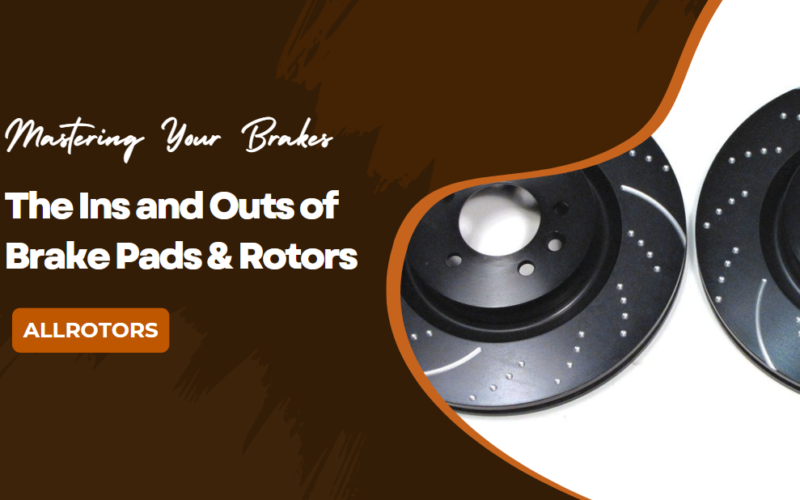Your brakes are the most important safety system in your car, so you can’t ignore those squeaks and squeals coming from your wheels. In this article, we will teach you the signs that your brake pads and rotors need replacing right away. We will also explain the different types of brake pads and rotors so you can make the right choice for your vehicle and driving style.
AllRotors specializes in providing high-quality brake pads and rotors, offering a local Canadian inventory for swift pickup or express delivery throughout North America. They emphasize personalized service and efficient logistics, including a convenient mobile brake replacement service. All products on https://www.allrotors.com/ come with an extended warranty and direct claims resolution, ensuring customer satisfaction and peace of mind.
Understanding Your Brake Pads and Rotors
Brake pads and rotors work together to stop your vehicle. As you press the brake pedal, the pads clamp down on the rotors, creating friction that slows the wheels.
Brake Pads
The brake pads are the main components that create friction against the rotors. They consist of dense materials like ceramics, metals, and resins which compress and grip the rotors when braking. Over time and use, the brake pads wear down until they’re too thin to function properly. At this point, you’ll start to hear squealing or scraping noises when braking, and you’ll need to have the brake pads replaced.
Brake Rotors
The brake rotors are the spinning discs that the pads clamp onto. As the pads wear down over time, the rotors also become damaged and warped. Warped or grooved rotors won’t allow the new brake pads to grip onto the surface effectively and can be dangerous. In some cases, rotors may need to be resurfaced or replaced when changing the brake pads. Resurfacing involves shaving off a thin layer of the rotor surface to make it smooth again, while replacement means installing entirely new rotors.
When to Replace Your Brake Pads and Rotors
Your brake pads and rotors take a lot of abuse over the miles, and eventually, they need to be replaced. Waiting too long can be dangerous, so it’s important to know the signs that it’s time for new brake pads and possibly rotors.
Squealing or Grinding Noises
If you hear loud squealing or grinding noises when braking, your brake pads are probably worn down to the point of needing replacement. As the pads wear out, the metal brake pad backing plate starts scraping against the rotor, creating these sounds.
Vibrations
Worn out or warped brake rotors can cause your brake pedal, steering wheel, or seat to vibrate when braking. The rotors become uneven as they wear down over time and miles. Uneven, worn rotors need to be either resurfaced or replaced, depending on their condition.
Longer Stopping Distances
If it feels like your vehicle is taking longer to stop, or isn’t braking as effectively as it used to, it’s time for new brake pads, at a minimum. As your brake pads wear out, they become less effective, requiring more pressure and time to stop your vehicle. For safety, it’s best to replace them right away.
Visible Wear or Damage
For those mechanically inclined, you can inspect your brake pads yourself through the openings in the wheel rims. If the pad material is worn down 1⁄4 inch or less, or is visibly damaged or torn, replacement is needed. You should also check your rotors for any deep grooves, rust, or other damage, which would also indicate the need for replacement.
Signs You Need New Brake Pads and Rotors
Squealing or Grinding Noises
One of the first signs that your brake pads and rotors need replacing is if you hear squealing, grinding or scraping sounds when braking. As the brake pads wear down, the metal brake pad backing plate starts making contact with the rotor, causing these noises. It’s best to have the brakes checked as soon as possible once you start hearing these sounds.
Vibrations or Shaking
If you feel vibrations, shaking or pulsating in the brake pedal, steering wheel or seat when braking, this typically indicates your rotors have become warped or damaged. The heat and friction created from braking can cause rotors to warp over time. Uneven rotor surfaces then make contact with the brake pads, causing the vibrations. It’s not safe to drive with warped or damaged rotors, so have them checked and replaced right away.
Car Pulling to One Side When Braking
If your vehicle pulls to one side when braking, it usually means your brake pads and rotors have worn unevenly. The pads and rotors on the side your vehicle is pulling to have worn down more. Uneven brake pad and rotor wear can also be caused by stuck or seized brake calipers. It’s best to have your brakes inspected as soon as possible to determine the cause of the uneven wear and have necessary parts replaced.
Spongy or Soft Brake Pedal
A spongy, soft or mushy feeling brake pedal is a sign your brake pads and possibly rotors are worn down significantly. As the pads wear out, the brake pedal has to travel farther to engage what’s left of the pads and rotors. This results in a loss of braking power and the spongy pedal feeling. If left unaddressed, worn out pads and rotors can become unsafe very quickly. It’s best to have your brakes checked right away if you notice a spongy or soft brake pedal.
How to Choose the Right Brake Pads and Rotors
When it’s time for new brake pads and rotors, you have some decisions to make. The options can be overwhelming, but choosing the right components for your needs and driving style is important for safe and effective braking.
Pad Compounds
Brake pads come in several compounds, from basic organic pads to high-performance ceramics. Organic pads are cheap, quiet, and low-dust, but tend to wear out quickly. Semi-metallic pads last longer but produce more dust and noise. Ceramic pads offer the best braking power and longevity for most drivers. For performance driving or towing, ceramics are a must.
Conclusion
So there you have it. Now you’re equipped with everything you need to know to keep your brakes in tip-top shape. Don’t put it off any longer – get those brake pads and rotors checked and replaced if needed. It’s not worth risking an accident or breakdown because of worn brakes.
Proper brake maintenance is key to safety and performance. By choosing the right pads and rotors for your vehicle and driving needs, you can maximize braking power and longevity while minimizing noise and dust. With proper maintenance and replacement when needed, your brakes can provide years of reliable service.
Here are the key steps to keeping your brakes in good shape:
- Inspect your brakes regularly for signs of wear like vibration, pulling to one side, longer stopping distances, and squealing or grinding noises.
- Have your pads and rotors checked by a mechanic at each oil change or yearly.
- Replace your pads when they have 2-3mm of pad material left. Rotors should be resurfaced or replaced when warped or scored.
- Choose ceramic pads for best performance and life, unless your driving needs warrant semi-metallic pads.
- Consider vented rotors for performance or heavy-duty use, but solid rotors work well for typical drivers.
- Stick with a reputable brand from an auto parts store for quality components at a fair price.
By following these tips and making sure your brakes are in good working order, you’ll avoid costly repairs down the road. Your brakes are one of the most important safety systems on your vehicle, so take care of them and they’ll take care of you. Drive safely!











